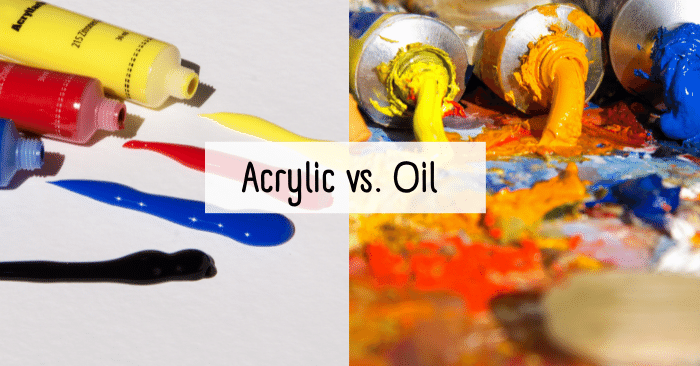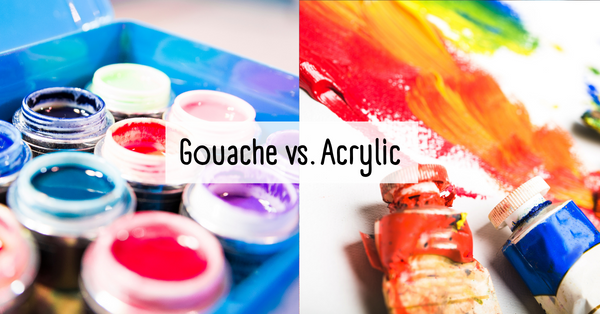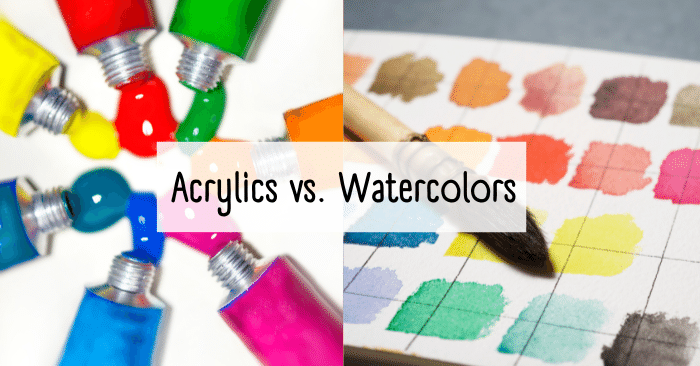
It can be overwhelming to choose a type of paint for your next art project when there are SO many options to choose from. While they all have their benefits and disadvantages, there’s a good reason why acrylics and watercolors are two of the most popular options on the market.
So, which one is better – watercolors or acrylics?
The truth is… neither! Each medium has its own benefits and unique qualities. Acrylic is quick-drying with excellent coverage and vibrancy, while watercolors are transparent and easy to blend with water. Keep reading to learn the other key differences between the two paints and which one is right for your next project.
TABLE OF CONTENTS
- What is Acrylic Paint
- What is Watercolor Paint
- Frequently Asked Questions
- Watercolors vs. Acrylics – Which is the Better Option for You?
What is acrylic paint?
Acrylic paints are water-based and will become water-resistant when dried. They are made from pigment suspended in acrylic polymer emulsion and plasticizers, silicone oils, defoamers, stabilizers, or metal soaps. They’re typically sold in jars, tubes, or bottles.
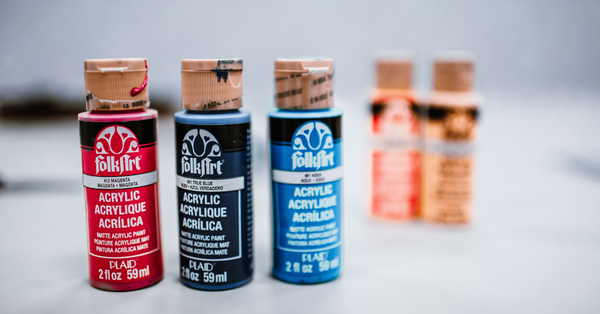
When compared to watercolors, acrylics have a much brighter, bolder appearance. However, these paints can easily be watered down to imitate a watercolor effect, making them slightly more versatile. You can also add white paint to acrylic pigments to lighten them and produce new colors.
Why are acrylic paints so popular?
Acrylics have become an extremely popular medium because of their fast-drying qualities, low toxicity, and ease of use. While beneficial from an efficiency standpoint, drying too quickly can be problematic for artists who are working to carefully add in subtle details as their piece progresses.
Also, acrylic paints don’t require toxic mediums to use, making them a safer option for artists and eliminating unpleasant odors. That said, acrylics still contain plastics which are harmful to the environment when not disposed of properly. So, you should still be cautious when using them!
What can you use acrylics on?
Acrylic paints are suitable for a wide range of surfaces including canvas, paper, wood, glass, and ceramic. They’re great for almost every type of painting or crafting project.
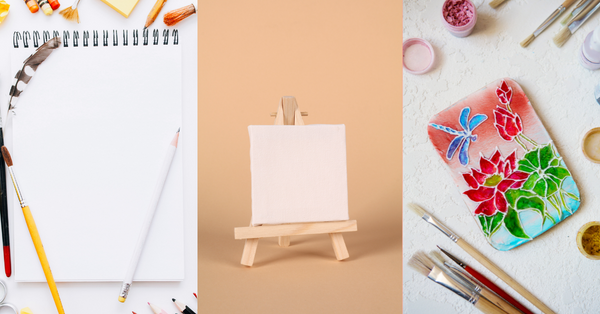
Be aware, though, that some colors will dry slightly darker than they first appeared on the canvas. Since acrylic dries quicker, it can also be more challenging to blend colors as you work, unless you keep a spray bottle filled with water nearby.
How do Acrylic Paints Compare to Watercolor Paints?
Acrylics are slightly more expensive than watercolors and can be more challenging to clean up, especially if clean up is delayed. Be sure to clean your paint brushes as soon as possible after using acrylic paints and avoid making a mess because once acrylic dries, it cannot be removed or altered.
Ultimately, acrylic paints offer more versatility, coverage, and vibrancy than watercolors. They can be used for a wide range of projects and are easy to incorporate into your portfolio of mediums.
If you’re interested in working with acrylics, we recommend the Arteza Acrylic Paint set which comes with 24 different colors and is great for beginners.
Tips for Working with Acrylic Paints
Interested in taking a stab at painting with acrylics? Follow these tips for best results:
- Prime Your Surface – Unlike watercolors, acrylics work better on a primed canvas. Some canvases come pre-primed, but if you purchase a bare canvas, be sure to take a few extra minutes to apply a layer of primer. Your finished painting will thank you.
- Clean Your Brushes After Each Use – Acrylic paint is very easy to clean off of your brushes; however, if you allow it to dry and harden, it becomes nearly impossible to remove completely. So, get in the habit of cleaning your brushes immediately after each use. It will save you time and money in the long run.
- Use Synthetic Paint Brushes – Synthetic brushes are best for acrylic paint because they’re durable and resistant enough to withstand the chemicals in acrylic paint. Plus, they aren’t too stiff or too soft, making them ideal for painting with acrylics.
What is Watercolor Paint?
Watercolor paints are made from colored pigments in a water-soluble binder, such as gum arabic. They often come in trays but are also occasionally sold in tubes. Watercolor pigments dissolve when water is added which is what gives them a translucent effect on paper.
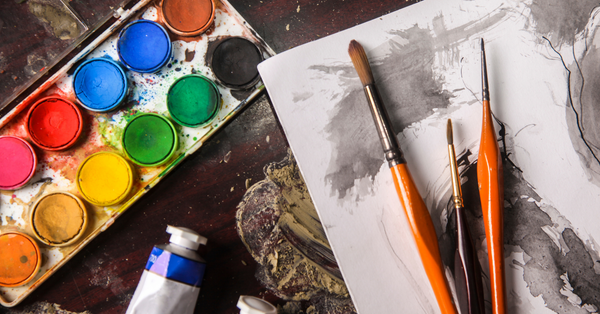
When compared to acrylics, watercolors offer a more natural transparency and softer finish. Rather than adding white to achieve a lighter color, you would instead need to add more water. This limits the amount of pre-blending and lightening you can do with watercolors. Watercolor also dries a bit quicker than acrylics.
Why are watercolors so popular?
Watercolors have become popular because of their unique, translucent appearance and low cost. You can always re-use any dried paint by simply adding water. They’re also safe to use and easy to clean up since they are water-based.
Unfortunately, their lighter consistency means they do not last as long and have less lightfastness than acrylics, meaning watercolors will fade over time if exposed to sunlight.
How do Watercolor Paints Compare to Acrylic Paints?
Although watercolors do not require any additional primers or mediums to use, they do require a specific surface to be effective. Watercolor paper is made specially for watercolor paints as it is thick enough to tolerate water without warping while also absorbent enough to receive the paint. Unlike acrylics which can be used on a variety of surfaces, watercolors are limited in their application.
Watercolors are slightly more eco-friendly than acrylics, since they do not contain solvents; however, some of the pigments used contain heavy metals which are harmful to the environment if not disposed of correctly.

Overall, watercolors offer an incredibly unique texture and consistency that is hard to find in other mediums. Techniques can be challenging to master, but the finished piece will have a wispy, natural feel to it that can’t really be accomplished with acrylic paints.
PRO TIP! If you’re new to watercolor painting, the MeiLiang Watercolor Paint Set includes 36 colors in a pan and is great for a beginner while also offering high-quality, professional results. Watercolor paints in a pan offer the advantage of being compact and easy to store. They also last a really long time, so are a great long-term investment.
The only potential downside is they don’t dry as vibrantly as watercolor paint in tubes. We recommend this Crafts 4 All Watercolor Paint Set for a tube watercolor set. It also comes with three bonus paint brushes. Keep in mind, however, they won’t anywhere near as long as a pan set, so get ready to replace them often!
Tips for Working with Watercolor Paint
Ready to test out your watercolor painting skills? Follow these tips for a beautiful first piece:
- Work From Light to Dark – When working with watercolors, you’ll want to paint the opposite way you normally would with other mediums. Start with your lighter colors first and then finish with your darks. This is because the lighter colors won’t really show up or “pop” if used on top of darker colors.
- Don’t Add Too Much Water – It can be tempting to add an ungodly amount of water to your colors, especially if you don’t realize water is being added each time you wet your brush. So, make sure to pat your brush with a dry cloth or paper towel before you put it back into the paint.
- Pick the Best Paper – As previously mentioned, watercolors require a special type of paint for use. Even still, you’ll have several options of watercolor paper to choose from. Take some time to decide if you need hard press or cold press paper before you head to the store. If you aren’t sure, check out our blog “Cold Press vs Hot Press Watercolor Paper: Key Differences You Need to Know” to learn more.

Frequently Asked Questions
Is acrylic or watercolor better for beginners?
While both options are safer and easier to use than something like oil paints, acrylics are more straightforward and mistakes can be easily covered or reworked. Acrylics can also be used on a wide variety of surfaces, whereas watercolors require special paper and turn out much better once you’ve developed the appropriate techniques.
Can you paint watercolor over acrylic?
Acrylic paint dries to a non-porous, plastic-like film, so watercolors will not adhere to its surface. However, you can create a beautiful painting by using acrylic paints on top of watercolors.
Can you use acrylic paint on watercolor paper?
Yes, you can, and you won’t need to prime the paper first! However, it is recommended to thin your acrylic paint with water first or use a thicker watercolor paper.
Can you mix acrylic and watercolor paint?
Yes, you can mix acrylic and watercolor paint together. This can create some interesting effects, but it is important to note that the two types of paint have different properties.
Acrylic paint is more opaque, while watercolor paint is more transparent. This means that mixing the two together can result in a slightly different appearance than if you were to use either type of paint alone. Experiment and see what kinds of effects you can create!
Acrylic vs Watercolor Paint – Which is the Better Option for You?
Both watercolors and acrylics have their place in the painting world. While neither is better than the other, there are certain situations in which you should opt to choose one over the other.
Acrylics offer a more accessible medium for the new painter, while also providing a more crisp, vibrant finish. On the other hand, watercolors require a little more practice to perfect the appropriate techniques but leave a unique, translucent, and wispy texture that’s great for realism.


